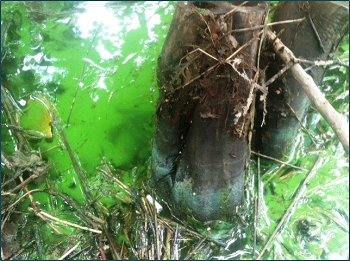By Dr. Christina Wilson and Mary Mengel

Although algae growth is common in lakes, ponds, and streams in Indiana, there are some fresh water algal blooms,such as those containing toxic cyanobacteria (known as blue-green algae) that can pose serious health problems in small animals, birds, aquatic species and livestock. Warm temperatures, combined with sunlight and moderate to high levels of nitrogen or phosphorus, can promote growth of the toxic cyanobacteria
Microcystis and
Anabaena.
1 Microcystis sp. blue-green algae can produce microcystins, which are potent hepatotoxins. Clinical signs in animals exposed to microcystins are associated with severe liver disease can and include diarrhea, vomiting, weakness, palor, recumbency, icterus and shock. In cases of acute toxicity, animals can die within a few hours.
2 Blood chemistries often reveal increased liver enzymes (ALP, AST, ALP), hyperkalemia and hypoglycemia.
2 Anabaena sp. blue-green algae produce anatoxin-a, which is a potent neurotoxin. Animals exposed to anatoxin-a may have a rapid onset of severe muscle tremors or muscle rigidity, followed by paralysis, cyanosis, or death. In cases of acute exposure, animals often die within minutes.
2Due to the rapid progression of clinical signs for both blue-green algae toxins, preventing exposure is key. Animals are exposed to toxic cyanobacteria through ingesting contaminated water or algae that has attached to their skin or fur after swimming through a toxic, blue-green algae bloom. Therefore, it is important to prevent access to suspect water sources, particularly those in which algal blooms are present. It is also important to prevent animals from accessing water sources that have been treated with herbicides or algicides to kill blue-green algae. After application of these chemicals, the algae cells die, causing large amounts of the toxins inside the cells to be released at once. Therefore, even though the algae bloom may not be visible, the water source can still pose a potential threat to animals.
In cases in which algal blooms are present, diagnostic testing can be performed on water samples at the ADDL to morphologically identify the algae and to detect the presence of the blue-green algae toxins anatoxin-a and microcystins. When collecting samples for diagnostic testing, collect water within 6 inches from the surface into a large, wide-mouth plastic or glass jar. Place sample on ice or refrigerate prior to submission. Use precaution when collecting water samples as the blue-green algae toxins are also dermal irritants.
References
- Puschner, B. and Roegner, A. (2012) Cyanobacterial (blue-green algae) poisoning. In: Veterinary Toxicology: Basic & Clinical Principles. R. Gupta (editor). Elsevier, Inc., San Diego, CA, pp. 953-965.
- Roegner, A. and Puschner, B. (2011) Blue-green algae (cyanobacteria). In: Blackwell’s Five Minute Veterinary Consult, Clinical Companion, Small Animal Toxicology. Osweiler, G.D., Hovda, L.R., Brutlag, A.G., and Lee, J.A. (editors). Wiley-Blackwell, Ames, IA, pp.687-695.